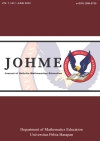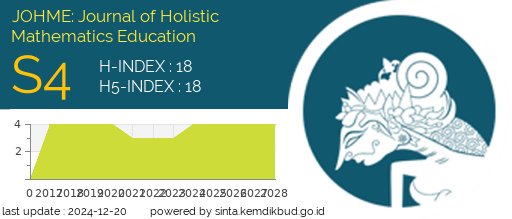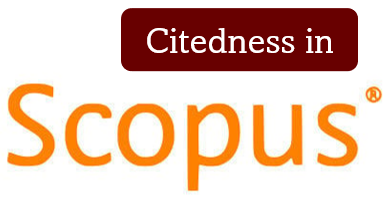PRE-SERVICE TEACHERS' PERCEPTION OF THE USE OF GEOGEBRA IN TEACHING AND LEARNING GEOMETRY IN THE COLLEGES OF EDUCATION, GHANA
DOI:
https://doi.org/10.19166/johme.v7i1.6124Schlagworte:
mathematics, geometry, GeoGebra, perception, pre-service mathematics teachersAbstract
The introduction of technology has given opportunities and made it easy for educators to utilize it in various ways, including in the field of education, as an instrument to support the teaching and learning of mathematics. GeoGebra is one of the mathematical software programs that can be effectively used in delivering mathematics lessons. GeoGebra is computer software that supports the teaching and learning of mathematics subjects, especially algebra, calculus, geometry, probability, and statistics. The objectives of this systematic analysis were to investigate pre-service teachers' perceptions and benefits of using GeoGebra to teach geometry. This study used a quantitative research design to review published articles from 2011 to 2021 related to the research objectives. This investigation purposefully sampled 17 published articles out of the over 200 articles found. The study used Google scholar, Google, and Sci Direct as the search engines to gather data using the keywords. The selected articles were validated using content analysis. This investigation selected the 17 articles for data analysis based on the research design, location, area of research, research focus and the type of technology applied. The findings of this study disclosed that pre-service teachers had the following perceptions regarding learning geometry with GeoGebra: GeoGebra enhances the teaching and learning of geometry, it helps learners to have positive perceptions concerning GeoGebra integration, GeoGebra improves learners' interest, motivation, and willingness to learn geometry. Also, it motivates learners to interact among themselves. Nevertheless, some benefits were identified as follows: GeoGebra increases students’ academic performance, develops learners' confidence in learning geometry, makes the learning of mathematics enjoyable, and helps learners to conceptualize abstract concepts in mathematics. Based on the findings of this study, it is concluded that GeoGebra is effective for teaching and learning geometry. This study recommends that mathematics educators should embrace GeoGebra software in the teaching and learning of geometry at the college level of education. Additionally, the Ministry of Education should enforce the integration of GeoGebra in the delivery of mathematics lessons.
Literaturhinweise
Agyei, D. D., & Benning, I. (2015). Pre-service teachers’ use and perceptions of GeoGebra software as an instructional tool in teaching mathematics. Journal of Educational Development and Practice (JED-P), 5(1), 14-30. Retrieved from https://ir.ucc.edu.gh/xmlui/bitstream/handle/123456789/8061/Pre-Service%20teachers%E2%80%99%20use%20and%20perceptions%20of%20Geogebra%20software%20as%20an%20instructional%20tool%20in%20teaching%20mathematics.pdf?sequence=1&isAllowed=y
Agyei, D. D., & Voogt, J. (2011). ICT use in the teaching of mathematics: Implications for professional development of pre-service teachers in Ghana. Education and Information Technologies, 16(4), 423-439. https://doi.org/10.1007/s10639-010-9141-9
Aliyu, J., Osman, S., Daud, M. F., & Kumar, J. A. (2021). Mathematics teachers’ pedagogy through technology: A systematic literature review. International Journal of Learning, Teaching and Educational Research, 20(1), 323-341. https://doi.org/10.26803/IJLTER.20.1.18
Alkhateeb, M. A., & Al-Duwairi, A. M. (2019). The effect of using mobile applications (GeoGebra and Sketchpad) on the students’ achievement. International Electronic Journal of Mathematics Education, 14(3), 523-533. https://doi.org/10.29333/iejme/5754
Amodu, L. O. (2007). Perception: A determinant for effective communication. Sophia: An African Journal of Philosophy, 9(1). https://doi.org/10.4314/sophia.v9i1.38774
Badu-Domfeh, A. K. (2020). Incorporating GeoGebra software in the teaching of circle theorem and its effect on the performance of students [Thesis]. Retrieved from https://ir.ucc.edu.gh/xmlui/bitstream/handle/123456789/4630/BADU-DOMFEH%202020.pdf?sequence=1&isAllowed=y
Bayaga, A., Mthethwa, M. M., Bossé, M. J., & Williams, D. (2019). Impacts of implementing GeoGebra on eleventh-grade students’ learning of Euclidean geometry. South African Journal of Higher Education, 33(6), 32-54. https://doi.org/10.20853/33-6-2824
Belgheis, S., & Kamalludeen, R. (2018). The intention is to use GeoGebra in the teaching of mathematics among Malaysian teachers. Malaysian Online Journal of Educational Technology, 6(1), 109-115. Retrieved from https://files.eric.ed.gov/fulltext/EJ1165486.pdf
Bowie, L., Venkat, H., & Askew, M. (2019). Pre-service primary teachers’ mathematical content knowledge: An exploratory study. African Journal of Research in Mathematics, Science and Technology Education, 23(3), 286-297. https://doi.org/10.1080/18117295.2019.1682777
Celen, Y. (2020). Student opinions on the use of GeoGebra software in mathematics teaching. Emerging Technologies in Computing, 19(4), 84-88. Retrieved from https://files.eric.ed.gov/fulltext/EJ1272890.pdf
Chalaune, B. B., & Subedi, A. (2020). Effectiveness of GeoGebra in teaching school mathematics. Contemporary Research: An Interdisciplinary Academic Journal, 4(1), 46-58. https://doi.org/10.3126/craiaj.v4i1.32729
DaÄŸ, F., Åžumuer, E., & Durdu, L. (2019). Pre-service teachers ’ perceptions and experiences: Course based on the active learning model and environment. Journal of Learning Spaces, 8(2), 41-56. Retrieved from https://files.eric.ed.gov/fulltext/EJ1229466.pdf
Dahal, N., Shrestha, D., & Pant, B. P. (2019). Integration of GeoGebra in teaching and learning geometric transformation. Journal of Mathematics and Statistical Science, 5(2), 323-332. Retrieved from http://www.ss-pub.org/wp-content/uploads/2019/12/JMSS19082102.pdf
Garth, A. (2008). Analyzing data using SPSS (A practical guide for those unfortunate enough to have to do it). Retrieved from https://students.shu.ac.uk/lits/it/documents/pdf/analysing_data_using_spss.pdf
Hohenwarter, M., & Lavicza, Z. (2009). The strength of the community: How GeoGebra can inspire technology integration in mathematics teaching. MSOR Connections, 9(2), 3-5. https://doi.org/10.11120/msor.2009.09020003
Horzum, T., & Ünlü, M. (2017). Pre-service mathematics teachers' views about GeoGebra and its use. Acta Didactica Napocensia, 10(3), 77-90. https://doi.org/10.24193/adn.10.3.8
Kakraba, E. Q. (2020). Effects of mastery-based learning approach on pre-service mathematics teachers’ geometry performance in Volta Region Colleges of Education, Ghana. American Journal of Educational Research, 8(9), 615-621. https://doi.org/10.12691/education-8-9-2
Markovits, Z., & Patkin, D. (2020). Preschool in-service teachers and geometry: Attitudes, beliefs, and knowledge. International Electronic Journal of Mathematics Education, 16(1), 1-15. https://doi.org/10.29333/iejme/9303
Mcdonald, S. M. (2011). Perception: A concept analysis [Dissertation]. Retrieved from https://www.researchgate.net/publication/225052960_Perception_A_Concept_Analysis/link/0a85e53247ea340142000000/download
Mokotjo, L. & Mokhele-Makgalwa, M. (2021). Mathematics teachers’ perceptions of the value of GeoGebra integration in South African high schools. African Perspectives of Research in Teaching & Learning, 5(1), 79-94. Retrieved from https://repository.up.ac.za/handle/2263/85934
Mukamba, E., & Makamure, C. (2020). Integration of GeoGebra in teaching and learning geometric transformations at the ordinary level in Zimbabwe. Contemporary Mathematics and Science Education, 1(1), 1-8. https://doi.org/10.30935/conmaths/8431
Mulder, D. J. (2017). Pre-service teachers’ perceptions of their abilities for technology integration: A mixed methods case study [Dissertation]. Retrieved from https://scholarworks.boisestate.edu/cgi/viewcontent.cgi?article=2336&context=td
Mwingirwa, I. M. & Miheso O’Connor, M. K. (2016). Status of teachers’ technology uptake and use of GeoGebra in teaching secondary school mathematics in Kenya. International Journal of Research in Education and Science (IJRES), 2(2), 286-294. Retrieved from https://files.eric.ed.gov/fulltext/EJ1105111.pdf
Naidoo, J., & Kapofu, W. (2020). Exploring female learners’ perceptions of learning geometry in mathematics. South African Journal of Education, 40(1), 1-11. https://doi.org/10.15700/saje.v40n1a1727
Salifu, A. S. (2020). Effect of GeoGebra on pre-service teachers achievement and perception of circle theorems at E. P. college of education, Bimbilla-Ghana. International Journal of Innovative Science and Research Technology, 5(8), 1202-1215. https://doi.org/10.38124/ijisrt20aug404
Segal, R., & Oxman, V., & Stupel, M. (2021). Using dynamic geometry software to enhance specialized content knowledge: Pre-service mathematics teachers’ perceptions. International Electronic Journal of Mathematics Education, 16(3), 1-8. https://doi.org/10.29333/iejme/11065
Shadaan, P., & Eu, L. K. (2013). Effectiveness of using GeoGebra on students’ understanding in learning circles. Malaysian Online Journal of Educational Technology, 1(4), 1-11. Retrieved from https://files.eric.ed.gov/fulltext/EJ1086434.pdf
Sunzuma, G., Masocha, M., & Zezekwa, N. (2013). Secondary school students’ attitudes towards their learning of geometry: A survey of Bindura urban secondary school. Greener Journal of Educational Research, 3(8), 402-410. Retrieved from https://zenodo.org/record/3478542#.ZDUKonZBzIU
Tamam, B., & Dasari, D. (2021). The use of GeoGebra software in teaching mathematics. Journal of Physics: Conference Series, 1882(1), 1-7. https://doi.org/10.1088/1742-6596/1882/1/012042
Ubi, E. E., & Odiong, A. U. (2018). Geometry is viewed as a difficult mathematics. International Journal of Innovative Science and Research Technology, 3(11), 251-255. Retrieved from https://ijisrt.com/wp-content/uploads/2018/11/IJISRT18NV72.pdf
Wassie, Y. A., & Zergaw, G. A. (2019). Some of the potential affordances, challenges, and limitations of using GeoGebra in mathematics education. Eurasia Journal of Mathematics, Science and Technology Education, 15(8), 1-11. https://doi.org/10.29333/ejmste/108436
Zakaria, N. A., & Khalid, F. (2016). The benefits and constraints of the use of information and communication technology (ICT) in teaching mathematics. Creative Education, 7(11), 1537-1544. https://doi.org/10.4236/ce.2016.711158
Zutaah, P., Miheso-O’Connor, M. K., & Ondigi, S. R. (2022). Pre-service teachers' performance in geometry in the colleges of education, Ghana. Journal of the European Teacher Education Network, 23-47. Retrieved from https://etenjournal.com/2022/06/20/3307/Downloads
Zusätzliche Dateien
Veröffentlicht
Zitationsvorschlag
Ausgabe
Rubrik
Lizenz
Authors who publish with this journal agree to the following terms:
1) Authors retain copyright and grant the journal right of first publication with the work simultaneously licensed under a Creative Commons Attribution License (CC-BY-SA 4.0) that allows others to share the work with an acknowledgement of the work's authorship and initial publication in this journal.
2) Authors are able to enter into separate, additional contractual arrangements for the non-exclusive distribution of the journal's published version of the work (e.g., post it to an institutional repository or publish it in a book), with an acknowledgement of its initial publication in this journal.
3) Authors are permitted and encouraged to post their work online (e.g., in institutional repositories or on their website). The final published PDF should be used and bibliographic details that credit the publication in this journal should be included.”










